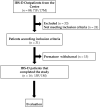Managing Symptom Profile of IBS-D Patients With Tritordeum-Based Foods: Results From a Pilot Study
- PMID: 35242794
- PMCID: PMC8886127
- DOI: 10.3389/fnut.2022.797192
Managing Symptom Profile of IBS-D Patients With Tritordeum-Based Foods: Results From a Pilot Study
Erratum in
-
Corrigendum: Managing symptom profile of IBS-D patients with Tritordeum-based foods: results from a pilot study.Front Nutr. 2023 Apr 14;10:1196030. doi: 10.3389/fnut.2023.1196030. eCollection 2023. Front Nutr. 2023. PMID: 37125042 Free PMC article.
Abstract
In the past few years, increasing attention has been given to the pathologic role of specific foods in IBS, like wheat and other cereals. Recent literature describes IBS patients who may experience gastrointestinal (GI) and extra-GI symptoms precipitated by the ingestion of cereals. Tritordeum is a cereal of Spanish origin derived from the hybridization of durum wheat and wild barley. It is different from classic wheat for its gluten protein composition, with fewer carbohydrates and fructans and a higher content of proteins, dietary fibers, and antioxidants. This pilot study aimed to investigate the effects of a 12-week diet with Tritordeum-based foods in substitution of other cereals on the profile of GI symptoms (evaluated by appropriate questionnaire) and the health of the GI barrier (assessed by sugar absorption test and different markers of integrity and functions) in 16 diarrhea-predominant IBS (IBS-D) patients. The diet with Tritordeum-based foods (bread, bakery products, and pasta) significantly reduced IBS-D patients' symptoms. This amelioration appears to occur through an overall improvement of the GI barrier, as demonstrated by the reduced intestinal permeability and the decreased levels of markers of intestinal mucosal integrity, mucosal inflammation, and fermentative dysbiosis.
Keywords: Tritordeum; diet; dysbiosis; gastrointestinal symptoms; inflammation; intestinal permeability; irritable bowel syndrome.
Copyright © 2022 Russo, Riezzo, Linsalata, Orlando, Tutino, Prospero, D'Attoma and Giannelli.
Conflict of interest statement
The authors declare that the research was conducted in the absence of any commercial or financial relationships that could be construed as a potential conflict of interest.
Figures





References
-
- Linsalata M, Riezzo G, Orlando A, D'attoma B, Prospero L, Tutino V, et al. . The relationship between low serum vitamin D levels and altered intestinal barrier function in patients with IBS diarrhoea undergoing a long-term low-FODMAP diet: novel observations from a clinical trial. Nutrients. (2021) 13:1011. 10.3390/nu13031011 - DOI - PMC - PubMed
LinkOut - more resources
Full Text Sources
Medical
Miscellaneous

